Unpacking and publishing the Phaistos Disk since 1993
HOME | PREVIOUS | NEXT | SITEMAP

The word miracle, from the old Latin word miraculum, means something wonderful and involves the
divine intervention of a supernatural being with the power to overturn the ordinary course of events or circumstances dictated by nature.
We usually identify this supernatural being as an angel, a winged being, and it is possible this was always the case. Whenever a miracle occurs,
humanity identifies the power behind it as having wings. This could explain why mythology tells of the invention of wings by Daedalus, and it could
also explain why, in mythology, Daedalus is sometimes elevated to the level of god in association with Dionysis of Crete. But something that
qualified as a miracle in the Mediterranean Bronze Age might be something we take for granted in our own time.
When did humanity first conceive of the four dimensions of length, width, height and time? What about the first three dimensions?
Was there a time in the evolution of human consciousness when the realization of height as the third dimension amounted to a miracle? Perhaps
humanity experienced the third dimension by looking up into the stars and thinking, "Heaven and eternal life are up there and it takes wings to be there."
This all must be in the processing of occurring because even as intellectually advanced as we claim to be in our modern era, it seems when looking at
the two-dimensional image of the Phaistos Disk we unanimously see only the dimension of width. The other dimensions are there but we do not
automatically see them right away.
First question we ask, "How big is it?" We think it must be really big to have all those pictographs on it. No, it is only a
little over six inches wide, the size of a small plate or a little bigger than a CD. "Well, what about the spirals? Do we start in the center
spiraling out or on the outside spiraling in?" It is round so we do not see length as a dimension, but instead our minds go for the spirals and
focus on the pictographs in the spirals. "What do the pictographs say? Is it a language?" Like young Greeks, we cast ourselves into the maze and
become lost in there. If Daedalus does not invent wings for us, we will never escape.
It is not easy to realize that, by our observation of this disk, we bring with us the third dimension of height, and this is
probably because of the missing second dimension of length. It seems our minds need length and width to arrive at height, and perhaps this is the
point of the story of Icarus who escaped the maze by flying out of it. Big thoughts in the Bronze Age might be about the conception of heighth as a
third dimension, thoughts big enough to engender a mythology about the person who "invented" it, big enough to be considered a miracle and the person
who delivered it to be considered a divine being. Have we not, in our own time, elevated Einstein almost to that status on account of his contributions
regarding the fourth dimension? Mythology tells us Daedalus and Icarus were trapped in the maze. They could not escape its length and its width and
so there was nowhere to go but height. There was nowhere to go but up.
After a few days of spiraling around and around this way, trying to travel the maze and read the pictographs like sentences in an
ancient script, I changed to the other way of looking at it, which is looking down onto it. In our modern vernacular, viewing the Phaistos Disk from
inside the spirals is a case of, "You can't see the forest for the trees," and this is the secret to the solution of this maze. You need to fly above
it like Icarus to really see it. This maze is further complicated by the entire disk being on flip sides of the same clay "coin," but this was
ingenious on the part of Daedalus because it kept the two sections intact for 3,600 years. The two sides have to be placed side-by-side to see what
it is all about. Looking down onto it seems better, to me, than running around lost inside it and finding only dead ends. Needing some guidance as to
what to do, I heeded the legend of Icarus, who escaped the maze by flying above it, and by doing so I found the third dimension of height as well as
an image that Daedalus invented.
Distributed in the spirals are 240 pictographs that many linguists insist are an ancient script. These signs were all impressed onto
the clay disk with tiny clay stamps. 48 stamps were used, 37 of which are repeated, 11 are single imprints. With the disk only a little bigger
than a CD, imagine how tiny the 48 stamps were that impressed 240 pictographs (121 one side, 119 the other). 48 just happens to be the number of the
constellations the Greek astronomer Ptolemy lists in the Almagest in the second century C.E., and from the ancient Greeks comes our system of
constellations that they apparently got from the Minoans. But then arises the question, did the Minoans originate this astronomy or was it borrowed
from the Bablylonians and the Sumerians? I believe the Phaistos Disk provides the missing link that proves the Minoans were excellent astronomers
in their own right. So excellent, in fact, that according to their own confession that seems portrayed on the disk, at least whimsically anyway,
they brought about the Minoan eruption and the tsunami with their excellent, but offensive, science and technology.
No longer was the disk just wide, but now I could experience length and height, and my mind soared like Icarus flying above the maze.
Is this what he saw when he flew so high that the sun melted his wings? Maybe this is what Theseus/Iasius saw from the Argo as he sailed the
heaven-ocean to land in Crete and battle the Minotaur, as portrayed in the
Maze of Daedalus tile mosaic. The convergence of those two mazes continues, square Maze of Daedalus and round Phaistos Disk maze, as they now
both portray pyramids, one an interior view and one an exterior view. But the Phaistos Disk conceals a pyramid with an interior view, as well.
The thought occurred to me this could be the Great Pyramid, and I was convinced this disk pyramid was not random coincidence.
With Crete so close to Egypt, and with the world's tallest structure for 4,000 years in Egypt, built nearly 1,000 years before the disk was created,
it does not seem far-fetched to imagine that Daedalus would put Cheops on a clay disk. Our fascination with the Great Pyramid never ends. Nearly
every person who sees it takes a picture of it. Daedalus, lacking a camera but wanting to preserve an image of it for posterity, could have put it
on this clay disk.
I wondered what else Daedalus put on the disk for posterity or for whatever reasons he had for creating it. Perhaps some
cataclysmic event urged him to create this pottery art masterpiece, something catastrophic such as the Minoan eruption and tsunami. This
masterpiece, created with an early printing press technology to record information, is truly remarkable. Like a CD, it allows something very
small to contain a great deal of information, in this case about a "lost" civilization. And if the pictographs on the disk were used like
symbols were once used in antiquity, to represent more than one idea or thing, the information contained on the disk could be extensive even
though the media itself is very small. If the information is really recorded there, I reasoned, then the discovery of it would be the educational
experience of a lifetime. With that in mind, I set out on an educational journey lasting the next 15 years of my life. With a Master of Science
for Teachers degree in English Education and a concentration in myth and saga (1976, Georgia Southern University), I enrolled
in the Phaistos Disk University to continue my education.
From my perspective, to study the Phaistos Disk is to study the universe and humanity's place within it via the perspective of the
first scholarly metaphysicians, the Minoan astronomer-priests. Their studies, much elevated beyond the simple mythologies of the time, were also
beyond the understanding and interest of most of the people of their age, and this is nearly always the case with metaphysics. But on the Phaistos
Disk may be recorded something unique, a cataclysmic event described in terms of metaphysics. The nearest thing we have to this is the Biblical
story of Noah's Ark and the Great Flood, and there is some possibility the Minoan eruption and tsunami engendered that story, as well as the
legend of the destruction of Atlantis. The Phaistos Disk might well be the Great Flood artifact and it may also be linked to the Biblical Tower of
Babel story.
1. Myth/legend of bull sports and bull-worship Greece had almost forgotten, though the poet [Homer] had not, that the island [Crete] whose wealth seemed to him even
then so great had once been wealthier still; that it had held sway with a powerful fleet over most of the Aegean and part of mainland Greece; and
that it had developed, a thousand years before the siege of Troy, one of the most artistic civilizations in history. Probably it was this Aegean
culture—as ancient to him as he is to us— that Homer recalled when he spoke of a Golden Age in which men had been more civilized, and life more
refined, than in his own disordered time. (Will Durant, Life of Greece)
Out in the deep dark sea there lies a land called Crete, a rich and lovely land, washed by the sea on every side and boasting
ninety cities. One of these cities is called Knossos, and there King Minos ruled and enjoyed the friendship of almighty Zeus.
(Homer)
According to popular legends of this Greek island in the Mediterranean Sea, Crete had many active ports, a powerful and
unchallenged navy, beautiful palaces, superb architects, excellent hydraulic engineers, and people who loved bull sports. But this Bronze
Age prosperity was no defense against the volcano, the earthquakes and the tidal wave that was supposed to have destroyed the Minoan
civilization in just one day and night. The civilization may not have been completely destroyed by the volcano. This legend of the
destruction of Crete by volcano may be the blending of events in history and mythology - the eruption of the volcano, the tsunami,
and the legendary destruction of Atlantis in just one day and night. The phenomenal civilization of Crete was greatly damaged by the
volcano and appparently rebuilt over a 500 year period.
According to one of the Cretan legends regarding Zeus-Dionysus, as related by
Athenæus, the animal which nourished with its milk the young god of
the cave was a sow. "Wherefore all the Cretans consider this animal sacred, and
will not taste of its flesh; and the men of Præsos perform sacred rites with the
sow, making her the first offering at the sacrifice. (Donald Mackenzie, Myths of Crete)
From our perspective, the advanced Minoan civilization is incompatible with our modern snobbery about the people who lived
thousands of years ago, but perhaps that is because we know so little about it. Minoans invented paved roads, and paved them with shells and rocks.
From all accounts of the people, they lived comfortably in adobe townhomes with rooftop patios and enjoyed plumbing and bathtubs. The queen's
bathroom at Knossos had a flushing toilet. The gay frescos on the walls of the palaces portray the people as wealthy, carefree, sophisticated
and uninhibited. They apparently lived well, had a healthy diet of pork, fowl, fish, crab, grain, fruit, olives and vegetables. And they
enjoyed the companionship of dogs.
Minoans wore various fashionable hats and headgear. Their clothing was very fashionable.
The spindle for cloth was necessary to fashionable Minoan Crete, where the designer of clothes oversaw the creation of the beautiful
gowns worn by the elegant women of Crete.
Just as the Phæacian [Cretan] men are skilled beyond others as mariners, so are the women the most
accomplished at the loom. The goddess Athene has given them much wisdom as
workers, and richest fancy. (Donald Mackenzie, Myths of Crete)
"The Cretans had
advanced into the later stage of Neolithic culture...and, as it is of special interest to note, clay
and stone spindle whorls, indicating that the art of spinning was well
known." (Mackenzie)
Crete had four major palace cities,
Knossos, Phaistos, Mallia and Zakro. The palace at Phaistos (left)
is a long way from a mud hut dwelling we might associate with the Bronze Age. (Why do we think we're so advanced, because we have washing machines,
dishwashers, and cars?) If Phaistos was overshadowed by Knossos alone, it must have been a magnificent palace. Phaistos was:
...a palace only less extensive than that of the Cnossus kings. Phaestus becomes a Cretan Piraeus, in love with commerce
rather than with art. And yet the palace of its prince is a majestic edifice, reached by a flight of steps forty-five feet wide; its halls
and courts compare with those at Cnossus; its central court is a paved quadrangle of ten thousand square feet; its megaron, or reception room,
is three thousand square feet in area, larger even than the great Hall of the Double Ax in the northern capital.
(Durant)
The central court at Phaistos probably was used for dancing and could have accommodated hundreds of dancers.
The Minoans were early Greeks, so it goes without saying they danced. Almost all the artifacts from Crete have spirals, so it goes without
saying they danced in spirals. Greek dancers still dance the pyrrhic, or Armed Dance, sometimes called Kronou Teknophagia,
meaning "Crane Dance" and the "Dance of the Labyrinth." In the tradition of this dance, the movements are performed from
right to left, then left to right, then stationary or slowly before an altar. Homer, in Chapter 18 of The Iliad, gives an account of a
dance floor designed by Daedalus for Ariadne at Knossos, where the dancers would dance in circles and then dance in lines. Mostly likely, the
circles were spirals, and the lines connected the spirals. The tradition of dance in Crete is an historical preservation.
A painting from Cnossus preserves a group of aristocratic ladies, surrounded by their gallants, watching a dance by gaily
petticoated girls in an olive grove; another represents a Dancing Woman with flying tresses and extended arms; others show us rustic
folk dances, or the wild dance of priests, priestesses, and worshipers before an idol or a sacred tree. Homer describes the 'dancing-floor which once,
in broad Cnossus, Daedalus made for Ariadne of the lovely hair; there youths and seductive maidens join hands in the dance.... and a divine bard sets
the time to the sound of the lyre. (Durant)
At Phaestus, about 2000, he builds ten tiers of stone seats, running some eighty feet along a wall overlooking a flagged court.
(Durant)
In Middle Minoan I the earliest palaces occur: the princes of Cnossus, Phaestus, and Mallia build for themselves luxurious
dwellings with countless rooms, spacious storehouses, specialized workshops, altars and temples, and great drainage conduits that startle the
arrogant Occidental eye. (Durant)
This spinning image is my exact tracing of side 1 of the Phaistos Disk (color inverted).
I dotted each of these matching pictographs (Minyae/Crested Dancers) on side 1 of the Disk and connected them with lines to find a triangle inside
two pentagons. I rotated the design clockwise, using a gif animation tool to make it spin. Like the Greeks in Dance of the Labyrinth, the disk
turns clockwise and counterclockwise at the same time. If only Daedalus could see this! It looks like he might have intended the cave design to
help create the idea of setting the disk in motion, and he did a very good job of it. I felt encouraged to give it a whirl to see what developed.
When the dancers cross from one side to the other, they cross from the 4th layer of one spiral onto the 5th
layer or outer ring on the other spiral. The dancers on the other side do the same, the two groups moving in circles in opposite directions, as
seen on his artifact from Crete. When they cross over they dance along the outside spiral first, and then they move in toward the inner circle.
When the inner circle is reached, they turn and dance in the opposite direction back to the other side. With their dance, the divine Curetes
protect the mother and child and celebrate the birth of a new Olympian. There, too, the skilful artist's hand had wrought, Hereon there danced youths and maidens whom all would woo, with their hands on one another's wrists. The maidens wore robes of
light linen, and the youths well woven shirts that were slightly oiled. The girls were crowned with garlands, while the young men had daggers of
gold that hung by silver baldrics; sometimes they would dance deftly in a ring with merry twinkling feet, as it were a potter sitting at his work
and making trial of his wheel to see whether it will run, and sometimes they would go all in line with one another, and much people was gathered
joyously about the green. (Homer, Iliad)
![]()
![]()
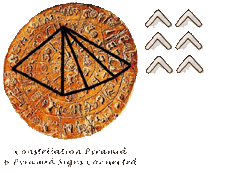 I started with the pictograph that first
caught my attention (left) and noticed that, depending on how you view the disk, this pictograph appears in an upright
position and looks like a pyramid. It takes up less room on the disk if it is in a vertical position rather than horizontal, and I thought that
perhaps Daedalus was trying to conserve space. Side one of the disk contains 6 of these. I wondered what would happen if I connected them with
lines, like connect-the-dots, since they are all identical. When I did that, I was astonished to find a pyramid.
I started with the pictograph that first
caught my attention (left) and noticed that, depending on how you view the disk, this pictograph appears in an upright
position and looks like a pyramid. It takes up less room on the disk if it is in a vertical position rather than horizontal, and I thought that
perhaps Daedalus was trying to conserve space. Side one of the disk contains 6 of these. I wondered what would happen if I connected them with
lines, like connect-the-dots, since they are all identical. When I did that, I was astonished to find a pyramid.
2. Very early myths of the Olympian gods and goddesses
3. Legend of Jason and the Argonauts pursuing the Ram with the Golden Fleece
4. The Sacred Oak of Dodona, Oracle of Dodona, legend of the Argos
5. Langue Argotique or Lost Language of the Argo
6. Legend of Daedalus and the Maze of Daedalus
7. Myth of the god Dionysis and legend of his biennial festivals
8. Legend of the Minotaur, the half-human, half-bull being
9. Legend of Greek dancers and the Crane Dance or Dance of the Labyrinth
10. Myth of Rhea, birth of Zeus in a cave in Crete, and the birthing stone of Zeus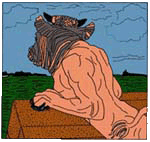 Minoan Crete (ca. 2000 BCE - 1200 BCE)
was a world cultural center, an island in the Aegean Sea, a cultural transmitter. The civilization of Minoan Crete was the epitome of
artistic achievement during the Mediterranean Bronze Age, which came to Crete ca. 2600 BCE. Crete was the first great sea power, easily
accessible with undefended settlements. Little is known, historically, about the Cretan religion, which involved worship in caves, on mountain
tops, and in domestic shrines. The Great Goddess may have been named Rhea, and Zeus might have been called Ja
(my opinion only). There were bull sports and bull sacrifice and a famous legend of the Minotaur - half bull, half human - who roamed the Maze of Daedalus
and ate Greeks. Twinkling in the night skies above were all the constellated gods, including Jason and the Argonauts in their constellated ship, the
Argo, that was made of psychic timber from the oaks of the oldest oracle in history, the Oracle at
Dodona, in the mountains of what is now northern Greece.
Minoan Crete (ca. 2000 BCE - 1200 BCE)
was a world cultural center, an island in the Aegean Sea, a cultural transmitter. The civilization of Minoan Crete was the epitome of
artistic achievement during the Mediterranean Bronze Age, which came to Crete ca. 2600 BCE. Crete was the first great sea power, easily
accessible with undefended settlements. Little is known, historically, about the Cretan religion, which involved worship in caves, on mountain
tops, and in domestic shrines. The Great Goddess may have been named Rhea, and Zeus might have been called Ja
(my opinion only). There were bull sports and bull sacrifice and a famous legend of the Minotaur - half bull, half human - who roamed the Maze of Daedalus
and ate Greeks. Twinkling in the night skies above were all the constellated gods, including Jason and the Argonauts in their constellated ship, the
Argo, that was made of psychic timber from the oaks of the oldest oracle in history, the Oracle at
Dodona, in the mountains of what is now northern Greece.
Put the people in their houses.
(My tracings, color added.)











 It is not easy for us to conceive of a Bronze Age
civilization creating "modern art." But if you take into consideration that their taste in art and their peaceful lifestyle had been
established for at least 1000 years, you can understand how they became brilliant artists, overreaching even modern art. Give art enough time
to develop uninterrupted, and it will. The Minoans, like the Mayas, enjoyed stylizing nearly everything in art. Even some of the pictographs
on the Phaistos Disk are stylized. This artistic approach makes some of those pictographs hard to identify. For example, left is an interesting
and nearly impossible pictograph to identify from the Phaistos Disk. I called it an amoeba for a long time before I thought to view it upside
down to see if I could identify it. As you can see, it is a stylized pig. It is also a sacred pig.
It is not easy for us to conceive of a Bronze Age
civilization creating "modern art." But if you take into consideration that their taste in art and their peaceful lifestyle had been
established for at least 1000 years, you can understand how they became brilliant artists, overreaching even modern art. Give art enough time
to develop uninterrupted, and it will. The Minoans, like the Mayas, enjoyed stylizing nearly everything in art. Even some of the pictographs
on the Phaistos Disk are stylized. This artistic approach makes some of those pictographs hard to identify. For example, left is an interesting
and nearly impossible pictograph to identify from the Phaistos Disk. I called it an amoeba for a long time before I thought to view it upside
down to see if I could identify it. As you can see, it is a stylized pig. It is also a sacred pig. ![]()
![]()
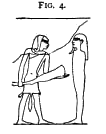 Here is another one that was tough to identify
because it is upside-down and stylized. I called it a trash can for a long time until I decided to see what it might be upside-down.
As you can see, it is most likely a hoof and leg of a bull, or perhaps an ox. The Egyptians had a ancient, sacred ritual involving the
cutting off of the bull's hoof and leg. After that, the bull's leg is presented in ceremony to Osiris (right, Papyrus of Ani).
Here is another one that was tough to identify
because it is upside-down and stylized. I called it a trash can for a long time until I decided to see what it might be upside-down.
As you can see, it is most likely a hoof and leg of a bull, or perhaps an ox. The Egyptians had a ancient, sacred ritual involving the
cutting off of the bull's hoof and leg. After that, the bull's leg is presented in ceremony to Osiris (right, Papyrus of Ani).
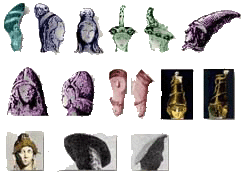



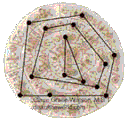 The central point in the star Sirius, directly beneath which is the island of Crete
represented by the flower at the center of side 1, would be what the Pythagoreans,
later on in history, understood to be the vertex, the zenith or point in the heavens directly overhead. Vortex has a correlation to vertex and means to
turn or rotate, which is one idea behind the spirals on the disk. If you turn or rotate the disk in a clockwise direction, you get an idea of the
concept of vertex-vortex because of the movement of the spiral when the disk is set in motion (below). An illusion is
created of a triangle that seems to spin counterclockwise inside two polygons that spin clockwise. The things chaotically mixed together by the
spin of the universe are organized by this geometry. This is like the stationary pole star and the precession of the other stars around it.
The central point in the star Sirius, directly beneath which is the island of Crete
represented by the flower at the center of side 1, would be what the Pythagoreans,
later on in history, understood to be the vertex, the zenith or point in the heavens directly overhead. Vortex has a correlation to vertex and means to
turn or rotate, which is one idea behind the spirals on the disk. If you turn or rotate the disk in a clockwise direction, you get an idea of the
concept of vertex-vortex because of the movement of the spiral when the disk is set in motion (below). An illusion is
created of a triangle that seems to spin counterclockwise inside two polygons that spin clockwise. The things chaotically mixed together by the
spin of the universe are organized by this geometry. This is like the stationary pole star and the precession of the other stars around it.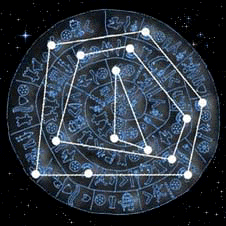
![]()
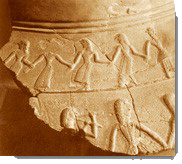 It is not impossible that Daedalus, wanting to demonstrate the principle
of motion relative to the observer, conceived of an optical illusion such as this and, lacking gif animation tools, used his imagination to set the disk
in motion. More likely would be the invention of a dance (left). In the Dance of the Labyrinth - Kronou Teknophagia or
Crane Dance - the dancers start in the center of one spiral and dance around to the center of the other spiral, while the dancers on the other
spiral do the same. A huge Phaistos Disk design like this one below might even have been drawn onto the dance floor!
It is not impossible that Daedalus, wanting to demonstrate the principle
of motion relative to the observer, conceived of an optical illusion such as this and, lacking gif animation tools, used his imagination to set the disk
in motion. More likely would be the invention of a dance (left). In the Dance of the Labyrinth - Kronou Teknophagia or
Crane Dance - the dancers start in the center of one spiral and dance around to the center of the other spiral, while the dancers on the other
spiral do the same. A huge Phaistos Disk design like this one below might even have been drawn onto the dance floor! 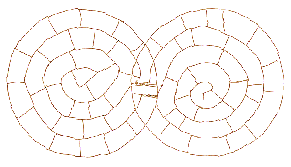
With curious
workmanship, a mazy dance,
Like that which Daedalus in Knossos erst
At
fair-hair'd Ariadne's bidding framed.
There, laying on each other's
wrist their hand,
Bright youths and many suitor'd maidens danced:
In fair
white linen these; in tunics those
Well woven, shining soft with fragrant
oils . . .
Now whirl'd they round with nimble practised feet,
Easy, as
when a potter, seated, turns
A wheel, new fashioned by his skilful
hand,
And spins it round, to prove if true it run:
Now featly mov'd in
well-beseeming ranks.
A numerous crowd, around, the lovely dance
Survey'd,
delighted. (Homer, Iliad, from Mackenzie)